A major consideration behind constructing a spacecraft that is often glossed over is the brain of the spacecraft. In most cases, this is a crew module, or a remote control module relaying orders from somewhere.
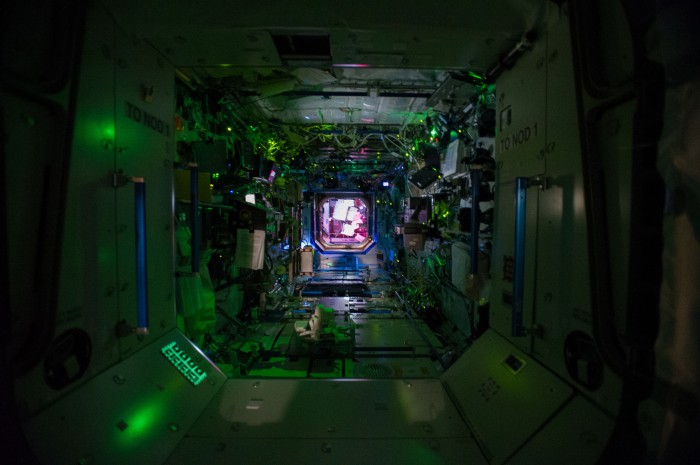
The reason crew compartments don’t receive the same amount of consideration, as say, the engines or the weapons, is that crew compartments have no real surprises about their design, and on larger capital ships, they are rarely a bottleneck in terms of mass, volume, power usage, or heat dissipation.
But before we discuss crews, what about alternatives? Crew provide decision making, the brains of the spacecraft, as well as providing fine grained manipulation of equipment and tools for repairs, maintenance, and so on.
The fine grained manipulation could be accomplished by minidrones, automated repair bots and the like, though handling unexpected situations is rather tricky without a human or artificial intelligence.

Brains of the spacecraft can be replaced with remote control, or with an artificial intelligence.
Remote control can be spoofed or jammed, but there are countermeasures and counter-countermeasure. The main issue with remote control is the speed of light lag. Beyond high orbit of a moon, for example, the speed of light lag is too great for combat. Additionally, long term journeys have much greater potential for unexpected failure.
This means remote control is restricted to drones and missiles, remotely operated and ordered by the nearest capital ship or celestial body.
Artificial Intelligence (AI) is an interesting solution to the problem of having crews. Crews are expensive to train, take up precious mass and volume, and require power. On top of that, the heat they need to dump out can be a problem if you want to talk Stealth in Space.
However, AI is more than a series of algorithms running on a laptop. Currently, certain problems of space warfare are best solved with algorithms (see Misconceptions about Space Warfare), such as leading targets hundreds of kilometers away moving at multiple kilometers per second.

On the other hand, other classes of problems are best solved with intelligence and creativity. In particular, how to see through enemy deceptions, laying deceptions, handling unexpected scenarios and failures, and so on are all problems that algorithms would fail badly at. Anything creative or anything an algorithm is not explicitly designed for would throw it for a loop.
That means full blown Artificial General Intelligence is needed for actually commanding a military spacecraft if you want to go without crew. Additionally, it needs to be able to very carefully and precisely control minidrones to repair and maintain a spacecraft.
The field of AI today is nowhere near that sort of capability. However, even if it does progress to being usable in military scenarios, it is unclear if it would be less massive, voluminous, or require less power than humans. The first AIs will likely be extremely massive and require huge amounts of power, and it’s not clear how far they could be miniaturized.
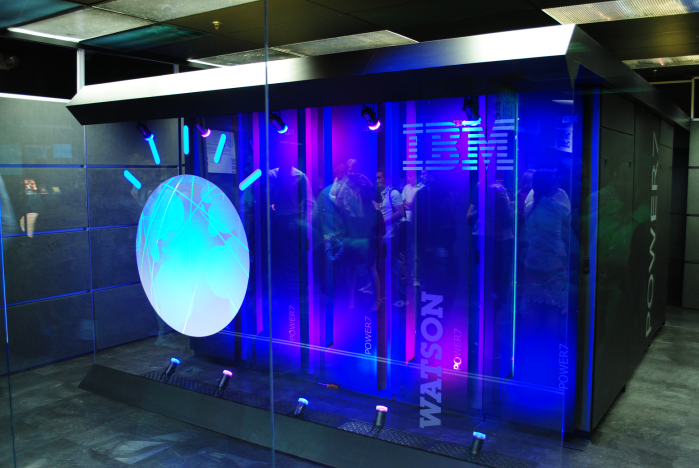
Even when feasible AIs are developed, space militaries would be very hesitant to deploy AI-controlled spacecrafts without at least some human oversight or failsafe.
With that in mind, we are left with crews for our capital ships, and remote controls for our missiles and drones.
But just how few people can you cram into a spacecraft? Modern Supercarriers crew over 4000 people in 25 decks. In space, most of that space would be propellant tanks, and you can’t really dedicate much mass to the crew compartment. Capital ships in space would run only skeleton crews, with only small sections of the spacecraft pressurized.
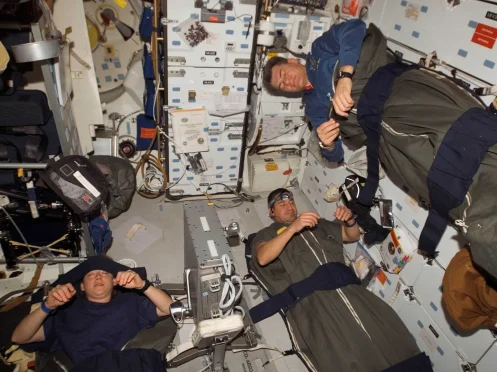
In space, crew modules are somewhat massive, yet systems like radiators, armor, and weapons usually take up far more mass.
Volume is the main problem with crew modules. Crew modules are mostly empty space filled with air. Even when you pack your humans in like sardines, the majority of the crew module remains empty space. Aside from the propellant tanks, crew modules take up the most volume of any module.
This makes Modern Nuclear Submarines the closest analog to spacecrafts in terms of crew: somewhat over 100 crew for a submarine over 100 meters long.
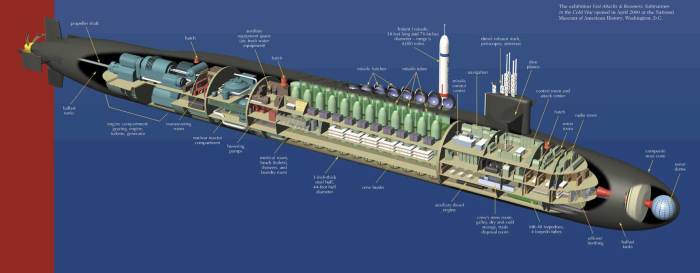
However, nuclear submarines are fully pressurized, while spacecrafts would not. This means spacecrafts would have even less space for people, and so crew requirements were estimated at roughly half that of a modern nuclear submarine. Of course, some jobs you can’t simply halve, and larger ships with more systems require more crew.
It should be noted that crew in a spacecraft is certainly not a novel topic. Winchell Chung’s Atomic Rockets website has a great break down on all of the considerations of crew.
In Children of a Dead Earth, most capital ships run between 40 to 80 crew, and are based heavily on modern nuclear submarine crews.

 These numbers are based on a tally of all the jobs needed, which scales based not by mass of the ship, but on the number of subsystems, type of subsystems, and several other factors. Thus, an enormous 10+ kiloton methane tanker can run on a tiny crew, while a small, 1 kiloton fast attack craft may require a much larger crew.
These numbers are based on a tally of all the jobs needed, which scales based not by mass of the ship, but on the number of subsystems, type of subsystems, and several other factors. Thus, an enormous 10+ kiloton methane tanker can run on a tiny crew, while a small, 1 kiloton fast attack craft may require a much larger crew.
 With such small crews, they would have to be highly trained to take over multiple jobs in case of injury or death of other crew members. Similar to modern nuclear submarines, crew members live 18 hour days, 6 hours on watch, and 12 hours off watch. Meals between each watch, with the enlisted men and women hot bunking to save on the precious space.
With such small crews, they would have to be highly trained to take over multiple jobs in case of injury or death of other crew members. Similar to modern nuclear submarines, crew members live 18 hour days, 6 hours on watch, and 12 hours off watch. Meals between each watch, with the enlisted men and women hot bunking to save on the precious space.
While a pure oxygen atmosphere (as seen on Skylab) is less massive and requires less pressurization than a 22% oxygen, 78% nitrogen atmosphere (as seen on the ISS), it is a fire hazard. And in combat, fire hazards are never fun.
 Water can be easily recycled as on the ISS. However, recycling food from human waste is a lot trickier, requiring a small ecosystem, likely using algae, to photosynthesize food from nuclear reactor grow lights. The technology to do this is much closer than AI is, and is very easily foreseeable as a staple in modern space travel.
Water can be easily recycled as on the ISS. However, recycling food from human waste is a lot trickier, requiring a small ecosystem, likely using algae, to photosynthesize food from nuclear reactor grow lights. The technology to do this is much closer than AI is, and is very easily foreseeable as a staple in modern space travel.
A complete algae ecosystem able to supply nearly infinite food would be excellent for long voyages with lots of crew, such as for a colony ship or space liner. However, the dumb solution is far simpler, cheaper, and less error prone. Store the food, just like how modern nuclear submarines work, and restock at every spaceport. And in combat, getting your provisions shot up is far less of a concern than getting your algae beds destroyed.
In Children of a Dead Earth, ships by default carry provisions for 6 months, which is greater than most campaign mission in game. Only a few missions exceed 6 months, and most are one month or less.
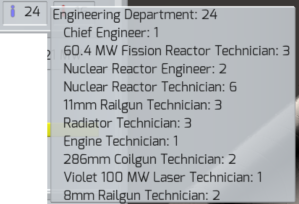 Crew modules produce a small amount of heat primarily from the lighting system, the galley cooking system (unless you’re forcing your crew to only eat Soylent), and the heat emitted by each crew member into the air. While the heat produced is minor (kilowatts) compared to the main reactor (megawatts), the low temperature (room temperature, 293 K) that the coolant runs at forces the radiators to be only somewhat smaller than the main reactor radiators.
Crew modules produce a small amount of heat primarily from the lighting system, the galley cooking system (unless you’re forcing your crew to only eat Soylent), and the heat emitted by each crew member into the air. While the heat produced is minor (kilowatts) compared to the main reactor (megawatts), the low temperature (room temperature, 293 K) that the coolant runs at forces the radiators to be only somewhat smaller than the main reactor radiators.
As mentioned in prior posts, radiation is a concern for crew, which is one reason why the cylindrical shape is preferred. Getting your crew module far away from the reactors is a free way to reduce radiation below the 50 milli-Sieverts annual limit. Additionally, radiation shielding, while not negligible, is cheap and low mass enough to not be too much of a concern. It tends to only be a mass or cost problem if you absolutely want your crew module next door to your reactor.
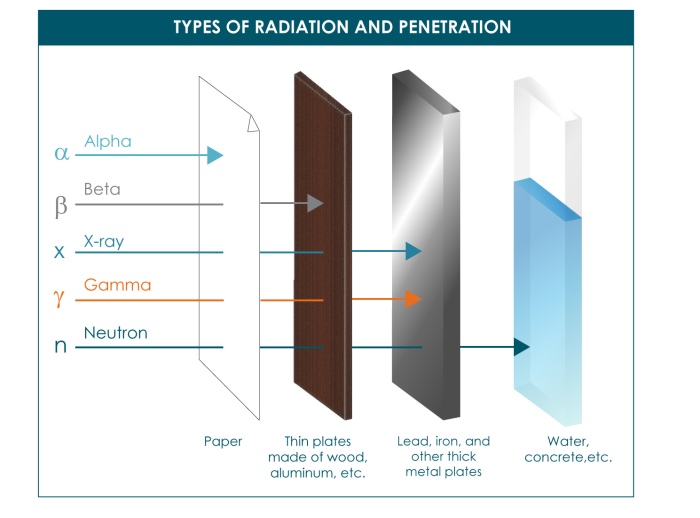
Children of a Dead Earth simulates all types of radiation, from Alpha Decay, Beta Decay, and Gamma Decay from Radioisotope Thermoelectric Generators, to Neutron Radiation (both fast and thermal) from Nuclear Fission Reactors. However, in practice, Alpha Decay and Beta Decay are more or less irrelevant to humans due to their low penetration, and Gamma Decay is rarely an issue.
Neutron radiation, on the other hand, is the bulk of the radiation problem, and it is often the main reason why your spacecraft will need radiation shielding. It generally is far worse of a problem than even the Cosmic Rays from space.
Another consideration mentioned a few times in previous posts is that crew modules are put close to the center of mass in case of fast rotations. Spinning a multi-kiloton spacecraft around fast enough to produce 9 g’s or more, enough to cause fatal damage to the crew, is rare, but it does happen in game. Keeping the crew near the center of mass reduces the centripetal acceleration on the crew in such cases.

It is very difficult to knock a multi-kiloton spacecraft into a fast spin, and if you have enough firepower to do so, you generally don’t need to slush the crew in this manner.
On the other hand, for smaller spacecraft, under a kiloton fast attack spacecraft, knocking them into a tailspin is actually rather common. To exacerbate this, small spacecraft with enormous projectile weapons can often knock themselves into unpleasant spins through recoil alone. As such, keeping the crew near the center of mass is most important on smaller spacecraft.
So that is what you need to keep your capital ships running smoothly over the months, and able to react to unexpected situations in combat! And with a crew, the brains of your ship, you have the final piece needed to assemble a spacecraft and go to war.
Probably not humanoid robots. Those are sort of OK at moving through spaces designed for humans and good at winning grant money but in an environment designed in conjunction with robotic use they don’t make any sense – at least near our current level of robotic technology.
Also, I’d actually expect that managing engagements would be one of the areas that AI would do best at in terms of replacing a captain. That’s exactly the sort of well defined task that you can train up an AI for if you need to. Something with the subtlety and insight of AlphaGo could certainly handle deception and counter-deception.
But, on the other hand, captaining a starship also involves more complicated things like diplomacy which I don’t expect AIs to be doing any time soon. Still, given current trends in the Navy towards greater automation like with the Zumwalt I wouldn’t be surprised at crews of a dozen for even fairly complicated ships.
LikeLike
I think that AI to address such open-ended situations is still fairly far in the future—I think a lot of people expect to get there this century, but the path to get there is not clear. AlphaGo was a great triumph for deep learning, since Go was thought to be intractable by older rule-based AI—but it is a relatively easy target for deep learning, with well-defined (and discreet!) feature and response spaces. Even a model to play COADE would probably be orders of magnitude larger, particularly in the feature space: even just selecting a target involves ranking enemy threats to your ships, then accounting for your relative effectiveness against various enemies. This either requires a bunch of multivariate models and some logic about what it all means (and it is the difficulty of providing such logic that has been driving AI research toward deep learning) or a model so complex that it can learn for itself what weapon, armor, and agility specs mean in practice.
LikeLike
While the heat produced is minor (kilowatts) compared to the main reactor (megawatts), the low temperature (room temperature, 293 K) that the coolant runs at forces the radiators to be only somewhat smaller than the main reactor radiators.
Why not use compressors and some type of gaseous refrigerant to pump the heat uphill, so that the temperature at the output stage of the compressor system (you might need several stages) is the same as the temperature used by the reactor coolant?
This should be a lot lighter than a large radiator and there are papers on the subject. Or this patent : https://www.google.com/patents/US6883588 .
LikeLike
Yeah, I did consider heat pumps and Peltier Machines for that purpose. It would help alleviate the issue, however it adds additional mass, cost, and power necessary. While that isn’t a deal breaker, it does transfer the issue around rather than fixing it. Low temperature radiators also can be made out of cheaper and less dense material (and armored more cheaply too).
I may implement heat pump radiator systems at some point in the future; at face value they only provided minor advantages over the current set up, so they weren’t a major priority.
LikeLike
I have to disagree with you on this one. Heat pumps are the premier solution to saving mass when dealing with low-temperature heat.
In a spaceship with no consideration for stealth, electric kilowatts are abundant. Kilograms are not.
Let’s assume pessimistic (yesterday’s technology) numbers for the heat pump. 64% work efficiency, based on stirling engines, with a heat-moving power density of 0.166kW/kg (based on free-piston stirling engine demonstrator figures for the SP1000 program).
300K heat, moved to 1200K, requires 3W of electrical input per 1W of heat moved. At 64% efficiency, 4.68W are needed.
An open-cycle life support system (no recycling) based on Apollo figures gives about 300W per crew member. NASA figures for a closed cycle (CLSS) experiments rise to 10kW per person.
For a crew of 100, this is a megawatt of life support.
At 300K, you’d need 2406m^2 of radiators. Your last ‘why does it look like that?’ post gave a 10.7 ton mass for a mere 60m^2 of radiator, which is 178kg/m^2. A life support radiator would therefore mass 214 tons (double-sided).
A 4.68MW heat pump would mass 28 tons. The new radiator area is 44m^2, massing 7.8 tons.
Mass savings are huge.
LikeLike
On the particular spacecraft design used as an example here, the reactor radiators mass 771 tons. The life support radiators mass 358 kg (not tons!). This is roughly a 2000x difference in mass.
The particular design (the Gunship) in question is a little extreme on the reactor side, as it has 56x the reactor radiator area as the life support radiator area. Other less extreme designs (the Corvette) have about 4x the reactor radiator area. However, the mass is still different by 100x.
The mass-area discrepancy is caused by two things. The life support radiators are made of far lower density material because their temperatures are so low (low melting point materials tend to be low density). They also skimp on armor because they are harder to hit and because of their low temperatures.
Consider a laser hitting the radiators. Melting point* is the most important factor when determining damage (though Specific Heat Capacity and Thermal Conductivity also play important roles), and the delta from the ambient temperature to the melting point is the key value. If you want 1000 K of “laser armor” so to speak, a life support radiator need only a melting point of 1273 K, whereas a reactor radiator running at 1600 K needs a melting point of 2600 K. Higher melting points require much higher density material.
*Actually, failure temperature is the key value, not melting point, but it’s linearly proportional to melting point, so the same ideas apply.
LikeLiked by 1 person
So IF droplet radiators worked, the performance increase would be incredible, right? From 771 tons to maybe 7 (the mass of the booms and guidance booms). Although you would also need to carry additional coolant because you would lose a little bit, albeit probably not much over mere 6 month duration missions.
I know that droplet radiators have never been demonstrated in space, although the basic principles are sound and there are euctectic metal combinations that would have a low vapor pressure at 1600K. (you’d have to use primarily tungsten in the coolant blend…)
You’ve mentioned before that the issue is that you can’t easily turn the ship with this type of radiator. And with fission power you can’t afford to shut off cooling.
But IF lightweight high specific power fusion is possible (yeah, not yet proven) AND droplet radiators can be made to work (you’d probably need to actively manipulate the droplet sheet by electrostatic plates and need a very fast control system that can observe the sheet surface as it flows) you’d get a lot more performance, right?
You could maybe shut down the fusion reactor or engine whenever you turn the ship so that you aren’t emitting as much waste heat. Then stop emitting and gather up all the droplets. This would of course be a big problem in combat because you would have to stop firing most weapons when turning the vehicle.
Can’t wait to pick up your game tomorrow.
LikeLike
I think droplet radiators are definitely feasible, and they would reduce mass costs heavily (since radiators are second in dry mass usage, armor being the main dry mass constituent).
The trick with droplet radiators is not only turning but also torque from enemy fire or from recoil. Smaller capital ships get easily knocked into nasty spins, which would immediately fling all of your coolant into space. Even for the larger ships (5-10 kt), heavy projectile fire and nuclear blasts can cause the ship to go into slow spins, and even slow spins can lose lots of coolant.
The ideal solution would be a radiator that magnetically contains its coolant. Something similar to the Curie Point Radiator or the Magnetically Focused LDR. However, even some of these solutions have acceleration tolerances estimated at 1 milli-g, so much more work needs to be done to get these to tolerate 100 milli-g’s to 1 g or more.
LikeLike
If you use a droplet radiator calculator you’ll find that the actual droplet sheet is mere kilograms of coolant. So you could carry 10 or 100 extra charges of coolant for that situation.
LikeLike
I have to ask, what do gunners do? Do they select targets for their weapons? It appears there is one person for weapon mount. That seems excessive.
What are six comm officers for? I mean, do you really need 2 people per watch watching comms? Same with astrogation.
Why is missile and missile launchers technicians are part of weapons department but all other weapon systems’ technicians are part of engineering department? Also, it’s interesting there is only one engine technician and 3 radiator technicians.
I’m sorry about all this nitpicking, but there is really some surprising stuff there.
Also previously I’ve noticed some systems require fractional crew requirements, like here: https://childrenofadeadearth.files.wordpress.com/2016/04/reactor2.png?w=700 How does it work?
LikeLike
I suppose I should have included an image of the craft. The craft is huge, one of the largest in the game (hence the 73 size crew). There are far more than one person per weapon mount, closer to one person per 5-10 weapon mounts. Gunners more or less babysit the targeting algorithms as they fire, checking to make sure the weapons are firing correctly, are not being deceived, and changing targets for the algorithms as necessary.
Missile technicians should be part of the engineering dept, that’s a mistake, thanks for catching it.
3 radiator technicians are needed, one for each watch, while engines are fired very rarely and don’t need daily maintenance and turbopump repair. On the flip side, the nuclear reactor technicians/engineers also work on the engines, since the engines are NTRs and have reactors within them. The pure engine technician only handles on the non-nuclear parts of the engines, the gimbals, the nozzles, the propellant feed.
Nearly all ships have 3 comms officers and 3 navigators, one for each watch. This particular ship is a bit unique in it’s size. It’s large enough that it’s treated as a flagship, the head of a fleet, and as a result, it features more crew than expected, like redundant comms officers and the like.
Fractional crew means you can have one person checking over multiple identical systems, but you need at least one, obviously.
LikeLike
Thank you. I wish you a smooth release and a great future for this project.
LikeLiked by 1 person
I look forward to the first real-life AI that beats human CoaDE players.
LikeLike
As multiple types of radiation are modelled, did you experiment with neutron bombs? If neutrons are the hardest thing to shield for, they seem like an obvious choice, at least at first.
Also, how is crew radiation damage modelled? It may be… awkward for engagements to end with all still surviving crew having 48 hours left to live due to radiation poisoning.
LikeLike
The problem with neutron bombs is the irradiance decreases quadratically (same with the energy in regular nuclear bombs). As mentioned earlier, moving your crew module far away from your reactor immensely reduces radiation for this same reason. This means for a neutron bomb to be effective, you have to detonate it right next to the crew module, which is quite difficult to aim for a missile moving at multiple km/s. Not to say impossible, but a normal nuclear bomb or a kinetic package would probably work much better if you have that kind of accuracy.
Some more discussion on neutron bombs: https://en.wikipedia.org/wiki/Neutron_bomb#Questionable_effectiveness_in_modern_anti-tank_role
As for crew radiation damage, it ends up being extremely small unless you have explicit neutron weapons. Even normal nuclear weapons don’t produce enough. 50 mSv is the annual max dose. The fatal dose even with treatment is 8 Sv, or 160x greater. If your radiation shields are destroyed, the annual dose will increase to maybe 100 – 500 mSv, but this is an annual dose. This assumes you don’t repair your radiation shields for a whole year after combat, which is not a likely case. Even if you don’t, you’re still 4x less than the fatal dose, so you’re talking treatable cancer after a year of flying with a broken shield.
LikeLike
How much does reactor shielding end up massing? In terms of optimizing a spacecraft, this always seemed to me like something you’d want to skimp on as it is dead weight. I thought of using reserve hydrogen propellant tanks as shielding. Apparently liquid hydrogen is a good, mass efficient form of shield, and if something goes badly wrong the crew can burn off some of that propellant. If things go really wrong they could burn it all, which would kill the crew but might save the ship…
LikeLike
If you put your crew modules far away, you can get away with very little reactor shielding (easily < 1 ton for a large craft). The reduction in radiation between 1 meter away and 50 meters away is 2500x, for example. If your crew module is fairly close, shielding starts to take up a lot of your dry mass.
A did experiment with using propellant tanks as shielding, since Methane and Hydrogen are great at shielding against neutrons. Trouble is, if a stray shot punctures your reserve tank, you lose all of your radiation shielding in one blow, while with multiple solid shields, it's a lot harder for stray shots to remove your radiation shielding.
LikeLike
I read the Wikipedia article but it’s talking about relative ineffectiveness with regard to quite thick and heavy *tank* armor. Would such armor be feasible on a spacecraft where every bit of mass ratio counts?
LikeLike
So the smart design would be to have your reactor in the aft of the ship, near the engines, radiators, etc., behind a nice solid rad-shield, and the crew capsule up front, well away from both it and any NTR engines. The intervening space would be filled with fuel tanks, structural girders, and various weapon systems and other non-living payload, and then everything gets wrapped in a nice armored shell to keep it safe – with the radiators strapped to the outside. Is that correctly understood?
LikeLike
Correct! Though this is only one configuration, the most common configuration.
Although for ships that are large enough, the crew capsule often is closer to the middle than the front. It may require additional shielding, but it saves the crew against fatal acceleration if the ship even is knocked into a spin.
Some of my testers have gone for very different designs. For instance, one tester is keen on a putting the NTRs on the middle of the rocket stack face every direction, and instead putting the crew modules on the very top and bottom, far away from them to reduce radiation. It works too, in its own way!
LikeLike
Do crew have multiple jobs, one for general quarters and one for normal operations?
Because it seems to me most of the menial work(swapping filters, cooking meals) doesn’t need to or should be done during general quarters, and doesn’t need much specialization since it’s relatively easy to learn.
LikeLike
Yes, the jobs listed are the “primary” job of the crewmember. For example, for the above ship, there are multiple “assistant doctors” or “combat medics” who have a different primary job, but only one crew member whose main job to be the doctor.
LikeLike
Shouldn’t there be a dedicated fireman on board? The number of naval histories I’ve read that see ships succumbing to fire is rather large.
Also: have any of your testers had a ‘sword’ shape for their spacecraft- a cone that expands to a limit then tapers into a longer cone getting smaller towards the rear? Basically <>>.
Currently your main design is <<<| if you can interpret the 'diagram' there. Wouldn't it be better to have things taper off towards the rear as much as possible to reduce the profile of the craft? (assuming engines could be fitted into a small space- I'm just thinking of reactor shielding and shaving off afew grams)
I apologize if this is a poorly phrased question. If so, I'll try and explain better when I have time tonight.
LikeLike
Remember that only living spaces are pressurized (and if they take enough damage to start a fire, they are likely no longer pressurized). I suspect fires are less of a concern on a spaceship due to the lack of oxygen through most of the structure, and when they do happen they are likely to be beyond fighting: think of propellant fires, or damage leading to sodium and water cooling systems leaking into each other.
I have wound up with a handful of “sword”-shaped ships, as you term them—I tend to prioritize keeping cross section low to keep the range at which I am targetable by kinetics low, and if my main thruster array has a smaller diameter than the max you can sometimes save some cross-section by balancing low-diameter sections front and back. It does lead to worse sloping when facing fire head-on, and if your reactor radiators are at the back, it puts them closer together (and thus more vulnerable to flak missiles).
LikeLike
To weigh in: Most of the spacecraft in CODE are unpressurized except for the crew compartments, and the crew compartments must have airtight partitions anyway
…not to say a fire isn’t impossible or deadly (bipropellants might mix, ammo might explode, the mess might suffer an accident) but it’s probably less likely to happen than in naval history, and less likely to spread out of control, simply because oxidizer isn’t inundating the entirety of the vessel inside and out.
LikeLike
as far as Automation and Precision goes … the Navy’s – Northrop Grumman X-47B – was able to connect with each of 3 Arresting Wires on the Carrier – a feat that is random for Human Pilots as the 2 of the 3 are in case the Human misses the 1st one, there are 2 more chances … so Fly here, launch these missiles and return should be really be that hard … there was also precision flying in the form of in flight refueling
https://en.wikipedia.org/wiki/Northrop_Grumman_X-47B
Northrop has also built the MQ-8 Fire Scout – the C Model is an off the shelf modified Bell Jet Ranger
https://en.wikipedia.org/wiki/Northrop_Grumman_MQ-8C_Fire_Scout
The Royal Navy is testing an Unmaned Speed Boat
https://www.theguardian.com/world/2016/sep/05/royal-navy-tests-unmanned-speedboat-ahead-of-drone-exercises
LikeLike
Haven’t you cast doubt on your arguments against AI by the very fact that you’ve created a space combat AI for your game? And yes good players will be beating that AI, but it’s running on modest hardware, hasn’t had military-grade money thrown at its development (but then nor have the human players), and isn’t getting the possible in-Universe benefits.
LikeLike
Minor correction – modern Supercarriers have more than 5,000 crew members in 8 decks, not 4,000 in 25. Crew live between the 4th deck and the 03 level (which is 7 decks total) with a VERY small number of crew living outside that area. Additionally, there isn’t much crew on the 01 and 02 levels – that space is largely taken up by the hangar deck.
LikeLike
Also, only about 80-85% of a submarine is pressurized, and for US/UK/FR subs at least, most crew sizes are 120-165.
LikeLike
How does crewmembers get inside crew module? I can’t see any airlocks or docking ports and crew modules placed within a ship under armor. Also, when refueling one ship from another or from station there is no pipes or any connections between ships so how fuel goes between them?
LikeLike
I think, the logical step is to simplify the subsystems so that they can be used and repaired far more easily and so efficiently used by far less crew.
LikeLike
I wanna if the nuclear pulse propulsion(like orion plan) is supported in this game.When I try to detonate nuke ( 2Mt ) in front of my ship(there is a 100m diameter pan covered with polyethylene),the ship’s velocity didn’t seem to change.So I want to know if nuclear pulse propulsion is possible in this game.Will there be plan to add such feature into game?
Thank you!
(Apologize for my poor English,English isn’t my first language)
LikeLike
This player made a nuclear pulse propulsion drive here: https://www.youtube.com/watch?v=NYdiBqzxeEo
LikeLike
There a few interesting points soon enough on this page but I do not determine if they all center to heart. There is some validity but I will take hold opinion until I check into it further. Great post , thanks and that we want a lot more! Put into FeedBurner at the same time
LikeLike
I have a comment about this aspect of the game. While I fully understand that, with weapons, efficiency and reliability are everything, completely disregarding the psychological health of the crew can be a fatal mistake. Packing 40 to 80 humans like sardines in a can and then sending them on a life-threatening, several months long mission in space is definitely asking for trouble. No matter how rigorous the selection, preparation and training, the human psychology has its limits. With this many potential stressors and the looming prospect of being shot at with thermonuclear missiles, lasers and railguns, it will all drive someone up a wall, and then it will spread like wildfire. And if the crew is of mixed sexes, that’s even worst. And I’m not sorry for saying this, we are what we are… and we have to take this into account… There were 707 allegations of sexual misconduct against army brass in 2019.
https://taskandpurpose.com/news/army-ig-investigations/
https://abcnews.go.com/US/military-sexual-assault-victims-system-broken/story?id=72499053
As a side note, it’s more than highly unlikely that you will be able to pick “the best of the best” for spaceship crews… You’ll have to work with the recruits that you get… It’s not like “the best of the best” queue up to join the army… They can usually make a living some other way…
Even civilian astronauts experience psychological troubles
https://en.wikipedia.org/wiki/Psychological_and_sociological_effects_of_spaceflight.
You have to foresee in the crew module at least some privacy and entertainment. Otherwise, the spaceship won’t even make it to engagement range.
LikeLike
Just TWO years later…
https://en.wikipedia.org/wiki/AlphaStar_(software)
And most real world military planning and executing works are not really more complicated than a pro-level SC2 game. 🙂
LikeLike